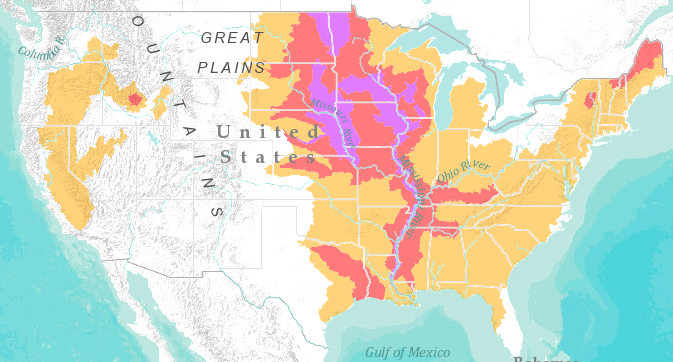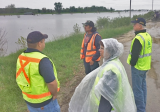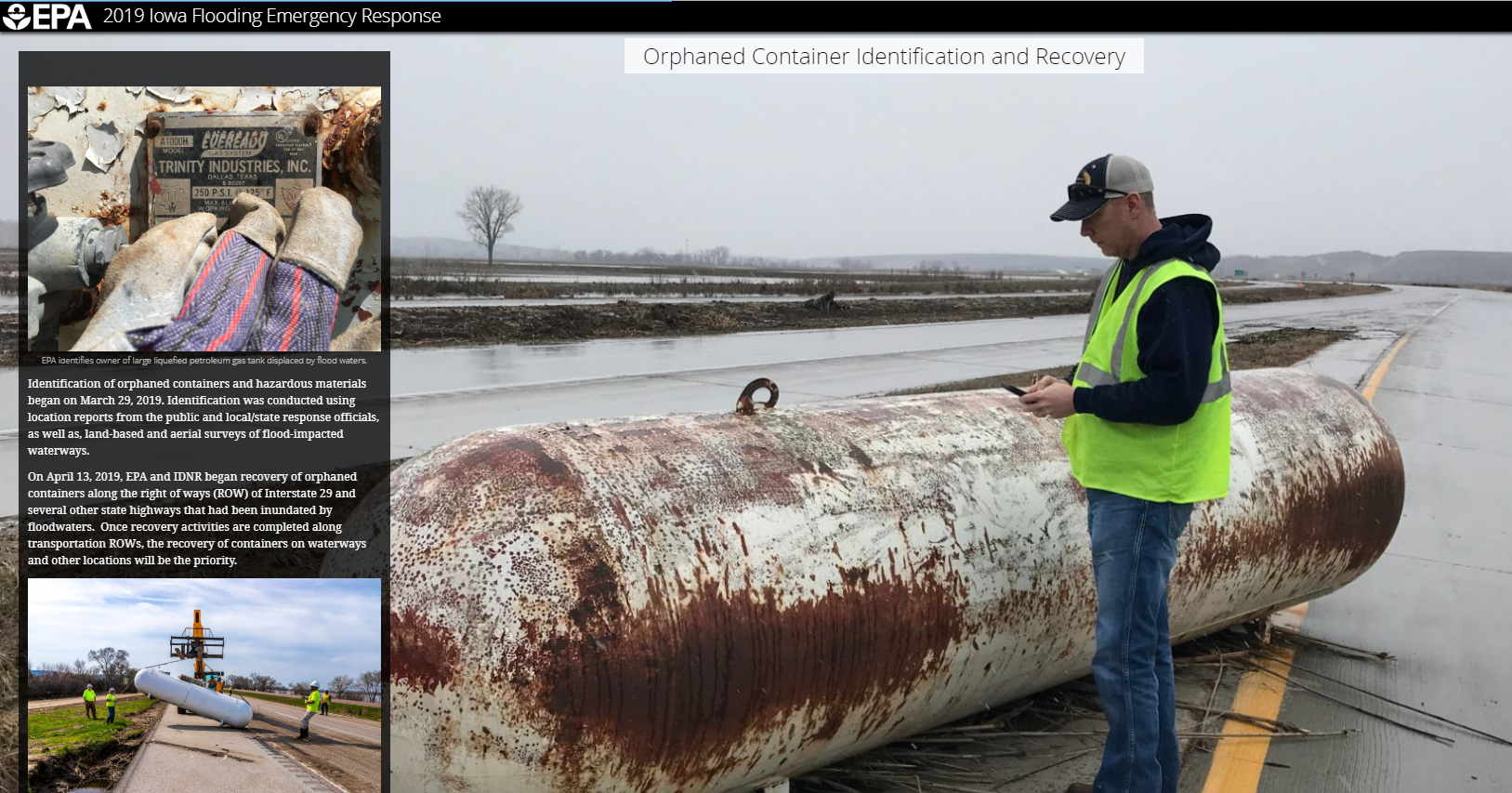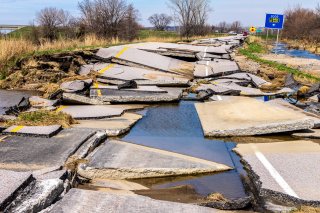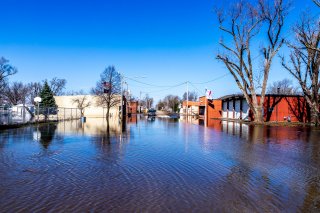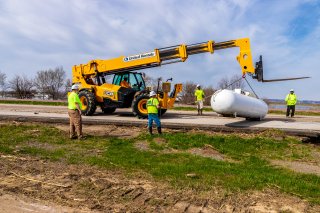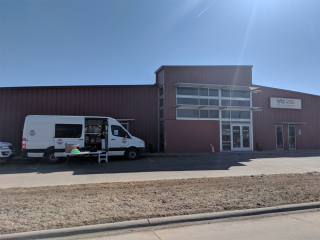EPA Assists States in Midwest Flood Zone of 2019
March 2019 precipitation resulted in flooding across the Midwest. Flooding was prevalent across western Iowa, particularly along the Missouri River and its tributaries. EPA was in immediate contact with all four states affected by the flooding – Nebraska, Iowa, Missouri and Kansas – to offer our assistance and hear what they foresaw as their most critical issues.
- EPA Region 7 Officials Visit Flood-Impacted Areas
- EPA Flood Response Story Map
- General Update: Tuesday, April 23
- Status Update: Friday, March 29 | Helpful Online Flood Resources
- Status Update: Wednesday, March 27
- EPA Testing Drinking Water and Preventing Diesel Spill with Federal and State Partners
EPA Region 7 Officials Visit Flood-Impacted Areas - May 2019
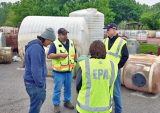
Jim Gulliford, EPA Region 7 administrator, Mary Peterson, EPA Region 7 Superfund and Emergency Management Division director, and Scott Hayes, regional incident coordinator for EPA Region 7, got a firsthand look at flood-impacted areas and EPA’s response activities in Iowa and Nebraska on May 20 and 21, 2019.
EPA Region 7 emergency responders have a Federal Emergency Management Agency (FEMA) mission assignment to recover tanks and containers displaced during recent floods in the two states. EPA began response efforts in March and is operating two separate responses in Iowa and Nebraska. As of May 20, EPA had recovered 1,567 containers in Iowa and 1,344 in Nebraska.
Those emergency responders continue to support the two states with hazardous material releases, oil discharges, and drinking and wastewater impacts due to the extreme flooding. Initial EPA response efforts included the review of all Superfund National Priority List sites and water/wastewater plants within the flood zone for health and environmental concerns. EPA Region 7 also checked the status of more than 600 sites that are part of EPA and the states’ hazardous materials compliance and management programs.
EPA Flood Response Story Map
-
Iowa flooding event
- EPA's mission and challenges
- Orphaned container identification, recovery and temporary staging
- Navigable orphaned container locator map
- How to report containers in flood debris
- EPA contact information
General Update: Tuesday, April 23
- EPA is addressing orphaned containers and spills/discharges of hazardous materials and oil, which are present as a result of the flooding, for the Federal Emergency Management Agency (FEMA) and the states of Iowa and Nebraska.
- EPA Region 7 reviewed all the Superfund National Priorities List (NPL) sites that were in the flood zone and found none of them to be cause for health or environmental concern. We also reviewed the status of more than 600 sites that were part of EPA’s and the states’ hazardous materials compliance and management programs.
- EPA is present at Joint Field Offices (JFOs) in Lincoln, Nebraska, and Des Moines, Iowa.
- EPA Region 7’s Division of Water staff reached out to all the water and wastewater facilities to determine their status and offer our assistance.
- EPA was initially “mission assigned” in Iowa for technical assistance to coordinate with response partners on March 24 and is presently acting on $570,000 in FEMA Mission Assistance, supporting Iowa with hazardous material releases and oil discharges (ESF #10).
- Orphan container recovery operations continue in Iowa, primarily along the I-29 corridor and levee areas, as requested by the state of Iowa.
- EPA was mission assigned in Nebraska for reconnaissance and to coordinate with response partners starting on March 24. EPA received an additional $2 million FEMA Mission Assignment for Nebraska on April 15 for oil and hazardous materials field operations, cleanup, and disposal of orphan containers. Collection of containers was projected to begin April 22 in the areas near Nebraska flood-impacted rivers and streams.
Status Update: Friday, March 29 - Midwest Flood Response
What is EPA doing?
-
A massive pile of concrete and asphalt sits along I-29 where an off-ramp once stood. Crews from state and federal agencies are working to reopen the interstate, where they found everything from missing sections to deteriorated shoulders and washed out culverts. EPA Region 7 on-scene coordinators have been removing tanks and displaced containers along the I-29 corridor. - EPA has identified Superfund sites impacted by floodwaters. At those sites impacted, the contamination is well below the surface and/or beneath engineered caps, which protect public health and the environment.
- EPA has confirmed the status of each Superfund site in the flooded areas.
- EPA and the Potentially Responsible Parties continue monitoring the sites.
What are the next steps?
- EPA personnel will further evaluate each site impacted by floodwaters to determine if any additional actions are required.
- EPA will direct agency and private resources to take any required actions that may be needed to protect public health.
- The actions may include testing for potential releases if site conditions have changed, including any damage to an engineered cap or significant soil disturbance.
What can you do to assist during the flood?
-
Roads, businesses and homes around Pacific Junction, Iowa, are inundated with floodwater that is slowly creeping out of the small Iowa town. Residents and public agencies will work with the Department of Transporation and other federal agencies, including EPA, in the future. Businesses are particularly hard hit with I-29 closed. Both local and state roads have been tremendously impacted by the flooding. - Household hazardous waste - common household items that contain hazardous ingredients
- White goods - can include refrigerant-containing appliances such as freezers, refrigerators and air conditioners, and other large appliances such as ranges, ovens, dishwashers, washers and dryers
- Electronic equipment - can include computers, televisions, game consoles, music equipment and stereo equipment
- The best way to protect yourself and your family is to stay out of floodwaters. They can contain chemicals and other hazardous material; electrical shock hazards from powerlines; human and livestock waste; household, medical, and industrial hazardous waste; and wastes that can contain arsenic, chromium, and mercury.
- While it isn’t possible to always know exactly what is in floodwater, commercial and government drinking water systems are tested continuously and are required to ensure drinking water meets health standards. If you drink private well water, you should have it tested if it was impacted by floodwaters. Some state agencies and local communities are offering well water testing in the Midwest. Check with your state environmental and public health agencies.
-
Each container, tank and tote must be handled with care, regardless of size. Objects that floated away with floodwaters and might carry chemicals are a threat to human health and the environment, similar to this tank picked up along the I-29 corridor. EPA Region 7 has a Federal Emergency Management Agency mission assignment to first identify and then recover orphan drums, containers and tanks. - Continue to listen for updates and announcements from local and state authorities for guidance on what to do if there is a chemical release.
Flood Resources
- Iowa Flood Center
- Disaster Assistance
- Flood-Related Disease Precautions and Information
- Flood-Related IDNR News Releases
- Flooding: How to Prepare, What to Do During, and How to Recover After
- Potential Well Water Contaminants and Their Impacts
- What to Do After the Flood (PDF)(3 pp, 386 K, About PDF)
Status Update: Wednesday, March 27 - EPA Region 7: Managing Superfund Sites Affected by Midwest Flood
- EPA has not issued any public health advisories or alerts due to the Midwest floods.
- EPA is working closely with our four state partners (Iowa, Kansas, Missouri and Nebraska) in response to the Midwest floods. We have personnel deployed to both the Nebraska and Iowa state emergency operations enters.
Among EPA’s actions, the Agency responded to the Midwest floods by tracking and monitoring Superfund sites.
Superfund Sites Requiring Action
EPA identified two Superfund sites affected by the flooding in the Midwest that required actions:
- Nebraska: At the Nebraska Ordnance Plant, near Mead, the site owner temporarily shut down treatment plants and extraction wells.
- Missouri: At the Conservation Chemical Corporation in Kansas City, the site owner maximized the volume of the groundwater extraction system to prevent migration of the groundwater contaminant plume. EPA continues to closely monitor these two sites.
Additional background information is provided on these two sites below.
EPA will continue to work with state and local response and emergency management officials to protect public health and the environment.
Sites Not Requiring Action
EPA has identified two additional sites that had water on the properties but did not require any actions by the Agency or site owners:
- Mid-America Tanning, Sergeant Bluffs, Iowa: This is a deleted National Priorities List site. Part of the site is underwater, but significant erosion is not anticipated at this time. EPA will assess if further action is needed after water recedes.
- Additional information about the site is available on its Site Profile Page.
- Railroad Avenue Groundwater, Des Moines, Iowa: EPA has not identified major impacts to the site. There is some standing water on part of the site. EPA will assess if further action is needed after flood water recedes.
- Additional information about the site is available on its Site Profile Page.
Sites Not Impacted by Floodwaters
EPA identified four sites that are not impacted by floodwaters, but have limited access due to flooded roadways. In coordination with our state and local partners, we will continue to monitor the floodwaters and the sites closely in the days ahead. No immediate actions are required at these sites:
- Iowa-Nebraska Light & Power, Norfolk, Nebraska: The site is not directly impacted by floodwaters, but fieldwork is delayed due to road closures.
- Additional information about the site is available on its Site Profile Page.
- Old Hwy 275 and N. 288th Street, Valley, Nebraska: The site is not directly impacted by floodwaters, but fieldwork is delayed due to road closures.
- Additional information about the site is available on its Site Profile Page.
- St. Joseph City Landfill, St. Joseph, Missouri: On Friday, March 22, aerial photos showed some floodwaters on top of an asphalt-covered area of the site. The site is currently not directly impacted by floodwaters.
- This is not a National Priority List site.
- Lawrence Todtz Farm, Camanche, Iowa: The site not directly impacted by floodwaters, but site access is limited due to road closure.
- Additional information about the site is available on its Site Profile Page.
Additional Background on the Two Impacted Sites
Nebraska Ordnance Plant, near Mead
Treatment plants at the former Nebraska Ordnance Plant treat approximately 2,680 gallons per minute to remove trichloroethylene (TCE) contamination from groundwater produced by eight extraction wells. Wellhead ultraviolet units treat groundwater contamination resulting from historical explosives manufacturing at the site. The treatment plants and extractions wells can be operated remotely.
To prevent potential impacts due to a lack of access, the U.S. Army Corps of Engineers (USACE) shut down all treatment plants and extraction wells on March 13. Operation of nearly all plants and extraction wells resumed on March 15. Operation of one extraction well was delayed until March 18, due to water in an underground electrical conduit (resulting from saturated ground conditions, not actual flooding).
EPA remains in daily contact with USACE, which manages treatment operations at the site to ensure protection of human health and the environment. Because the contamination being addressed at the site is in the groundwater, exposure to contamination as a result of floodwater is not expected.
EPA will assess if further action is needed at the conclusion of the flood event.
Additional information about the site is available on its Site Profile Page.
Conservation Chemical Corporation, Kansas City, Missouri
The Conservation Chemical Corporation site is situated within the floodplain of the Missouri River, on the river side of the levee. As such, the site has experienced infrequent flooding previously. During previous flood events, there were no releases of hazardous contaminants from the site.
During this flood event, water is present inside the perimeter fence but remains isolated from, and does not cover, soil above the in-place hazardous waste. Stone riprap is in place around the site to protect against erosion from floodwaters. Because the contamination being addressed at the site is in the groundwater well below the surface, exposure to contamination as a result of floodwater is not expected.
The groundwater extraction system is operating at maximum capacity and has maintained inward gradient during this flood event to ensure that groundwater contamination will not spread.
EPA will assess if further action is needed at the conclusion of the flood event.
Additional information about the site is available on its Site Profile Page.
EPA Testing Drinking Water and Preventing Diesel Spill with Federal and State Partners
EPA is operating in the 2019 Nebraska flood zone with federal and state partners. After a request from the Nebraska Department of Health and Human Services (NDHHS) in March 2019, EPA deployed a mobile laboratory and staff to sample private drinking water wells for E. coli contamination. Meanwhile, at Offutt Air Force Base near Omaha, EPA on-scene coordinators have been working with the U.S. Air Force and response officials to prevent a diesel spill from one of the 1-million-gallon diesel fuel tanks that had been inundated by floodwaters.
Water Testing for E. coli
EPA Region 7’s Science and Technology Center provides laboratory testing support to states whenever possible.
“The key thing is our ability to respond, even without an immediate mission assignment, because of the need of the citizens of Nebraska to be able to characterize their drinking water wells and private drinking water supplies,” said Mike Davis, EPA Region 7 monitoring and environmental sampling branch chief. “We’re testing for E. coli, which is the major contaminant of concern for private drinking water wells in a flood situation.”
EPA’s ability to respond to state partners’ requests for drinking water sampling assistance is an example of the Agency’s cooperative federalism priority. Working together with the state of Nebraska, EPA will address the citizens’ immediate concerns about private drinking water supplies.
The mobile lab will travel from Fremont to Norfolk on the morning of March 22, where the team will continue to test private wells until the morning of March 23. That afternoon they will travel to Verdigre, where they will conduct additional testing of private drinking water supplies through the morning of March 24.
In addition to sending the mobile laboratory to sample private drinking water supplies, EPA is sending additional personnel to collect samples to return to EPA’s Science and Technology Center laboratory located in Kansas City, Kansas.
Turnaround time for samples analyzed by both the mobile lab and the Kansas City lab is 24 hours. EPA’s ability to quickly collect and analyze drinking water samples for E. coli plays a critical role in protecting public health during flooding events.
The state of Nebraska is also analyzing public drinking water samples at the Nebraska Public Health Laboratory, which has currently committed to sampling at least 100 private drinking water samples.
“It’s a true partnership between us and the state of Nebraska and the NDHHS,” Davis said.
Preventing Diesel Spill at Offutt Air Force Base
EPA's assistance to Nebraska extends beyond sampling private drinking water supplies. The Agency also deployed two on-scene coordinators (OSCs) to Offutt Air Force Base near Omaha on March 18, in response to a reported oil spill.
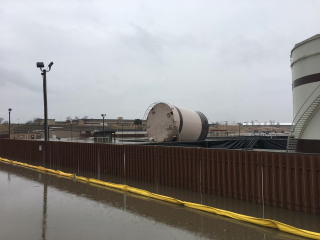
At the base, EPA OSCs met with Air Force officials about the flooding and inspected a 1-million-gallon diesel fuel tank containing more than 44,000 gallons of diesel that was listing as a result of high waters. The OSCs oversaw Offutt officials placing 3,400 feet of containment boom around the tank farm and pumping floodwaters from secondary containment areas, in case of a release from one of the fuel tanks.
“The Superfund program stands ready to assist our partners throughout Region 7 when potential releases threaten human health and the environment,” said EPA Region 7 Superfund Division Director Mary Peterson. “Our OSCs worked closely with the Air Force and response officials to ensure that diesel fuel in the tanks remained contained.”
With no release of diesel fuel from the tanks observed at the base, and the containment boom in place along with ongoing pumping of secondary containment areas, the EPA OSCs demobilized and returned to EPA Region 7 Headquarters on March 20. EPA remains ready to assist the base, if a release or threat of release from the tanks requires additional response actions.


